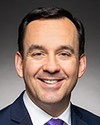Thank you, Mr. Chairman, for this opportunity to meet with your committee to discuss public transit issues. The Canadian Automobile Association is very pleased to meet with your committee early in its mandate. My colleague Jeff Walker, our vice-president of public affairs, and I would be pleased to take your questions after these remarks.
I am reasonably sure that many, if not most, of the honourable members who serve on the Standing Committee on Transport, Infrastructure and Communities are among the 5.6 million members of the Canadian Automobile Association. However, let me take a few minutes to explain our organization and the unique perspective we are able to bring to bear on transportation issues.
Across the country, and in every region, the CAA brand is one of Canada's most recognized and trusted. Our roots go back a century to the early days of the automobile, when motoring enthusiasts would gather together to urge governments to build better roads, install proper signs, and establish reasonable speed limits. Our clubs and our national association were in fact founded by groups of concerned motorists to lobby for safer, better roads. The emergency roadside service and other services CAA is known for today came later. Public policy advocacy on behalf of our members is in our DNA.
Today, we are an affiliation of nine automobile clubs whose members rely upon those individual clubs to deliver exemplary roadside assistance, travel, insurance and member rewards. They also rely on us to deliver honest, reliable information on topics that matter to them, and to make sure decision-makers hear their voices.
The nine member clubs operate some 130 community offices across Canada and these offices are the delivery points for the visionary, community-focused work that has become CAA's hallmark in every region. By working together with a national organization, the strength of the whole becomes greater than the sum of the nine individual parts.
Here in Ottawa, CAA National works with member clubs to support and protect the CAA brand, including standards that apply to all member clubs, and the accreditation of these member clubs. Where needed, we lend our help to programs and services provided by the clubs. We maintain relations with national and international organizations outside of Canada, such as the American Automobile Association. The national office also provides public education, unbiased information, and a voice in Ottawa to our members on the issues they tell us they care about, from texting while driving to ways to economize on fuel that benefit the pocketbook and the environment to explaining new vehicle technologies such as hybrids and electrics.
The issue of texting while driving illustrates how we work. Our member surveys have identified this as the number one road safety concern of members and the general public alike, surpassing even impaired driving as of last year. As a result of what our members tell us, we have made it a priority to work on this issue. We have launched a youth video contest called Practise Safe Text; we will be convening major experts to discuss the issue next March; and we have done dozens of media interviews to publicize the issue. In doing so we are working with our partners, including Transport Canada, to reach as many people as possible.
We don't just consult our members on road safety issues. In partnership with Harris Decima, we conduct extensive member research surveys twice a year to measure issue awareness, identify topics, gather insight, and as a reality check for where we are directing our programs and activities. We survey 4,000 Canadians each time, both CAA members and the general population. The sample size is designed to be large enough so that we feel we can speak with some confidence on the Canadian public opinion in general.
Equipped with the results of our research, the national office also plays a strong advocacy role at the federal level. Past efforts have included highlighting the importance of road infrastructure, for example, and we were very encouraged when the stimulus package introduced as part of the economic action plan put such a priority on roads.
In all we do, we are informed by the opinions of our members. We are committed to building safe communities that provide mobility to all, not just to better roads, but to a better transportation system for all users. We are committed to mobility.
Our starting point here—and this will be no surprise—is our membership. The average CAA member isn't just a driver, but also takes transit, and even rides a bicycle from time to time. This should not be surprising. Many Canadians, especially those in large urban areas, use transit at least part of the time to get to work. They hop in their vehicle to run errands and ferry the kids to activities at night. And on the weekend when the weather is nice, they haul the bicycles out of the back shed and go for a ride.
That is why we like to talk about mobility. It is a recognition of where modern CAA members—and Canadians—are in their lives today.
This brings us to the issue of public transit. Mobility is about much more than cars and trucks, roads and bridges. It requires an integrated approach to transportation that includes public transit, passenger rail, and even bike paths.
Our goal at CAA is neither to put more drivers on the highways and roadways nor to tell them that they are misguided if they do not take transit or bikes to work. Our goal is choice and overall mobility for the Canadian population. Efficient, available public transit and bike paths, where they make sense, take vehicles off the road. It is a win-win situation for motorists, shippers, and transit users alike.
According to our most recent research data, 15% of Canadians use public transit as their primary mode of transportation, compared to 76% for the car or truck. The numbers for our members are lower: 90% are primarily drivers, and only 5% rely on transit as their primary means of getting around. But 31% of the general population takes transit at least some of the time, and 23% of our members do the same. Among those who cite transit as their primary mode of transportation, our members take it, on average, 2.8 days per week. The comparable figure for the general public is 3.5 days per week.
Leaving aside these statistics, the plain fact is that the majority of transit in this country runs on roads. How well it functions has a direct bearing on all road users, whether they're on the bus, so to speak, or not.
An improved system of public transit, especially in our major cities, would be welcomed by CAA members. Public transit is an important part of reaching our goal of improving the mobility of our members. They want to spend less time stuck in commuter gridlock. They want driving to be a safer, more efficient, more enjoyable mode of transportation. Public transit helps take cars and trucks off the highways and roadways to the greater advantage of both those who use their personal vehicles and those who use public modes.
We noted with pleasure Minister Lebel's recent statements that he is committed to working with stakeholders on a future plan to deliver transportation infrastructure funding to Canada's provinces and municipalities.
Based on our experience as a federation, we believe that determining the exact mix of funding, between transit, roads, and other municipal infrastructure for each community, is best left to the provincial and municipal levels.
What is clear however is that stable, long-term funding will allow for proper planning. At CAA, we always try to focus on pragmatic solutions.
In that spirit, we are agnostic on how the federal government should deliver its share of transit funding. What is important is to achieve the goal of stable, multi-year funding so that funds can be best spent.
We would also ask the government to ensure that its criteria for funding give the provinces and municipalities leeway to invest in longer-term projects. For instance, at CAA we are working with researchers at the University of Calgary and the University of Toronto on so-called intelligent transportation systems that marry roadway video, transit information, GPS, and sophisticated modelling to plan the best possible traffic flow for all users. This allows government to squeeze more volume per kilometre of road, an efficiency that is good for the economy and for individual users.
In closing, I have one more reference to our members' data. Fewer than half our members rate the state of public transit infrastructure in Canada as adequate or better. The actual number is 46%, compared to a barely better 52% among the general population. Surely as a country we can do better.
As a federation of nine clubs, we understand very well that one size does not always fit all.
We know that transportation infrastructure is an area of shared responsibility. We note again Minister Lebel's commitment to hold up the federal government's end of the bargain, and we stand ready to assist this committee in any way we can in its deliberations.
Thank you for the invitation and the opportunity to speak, and we welcome the committee's questions.











